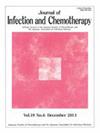治疗骨关节感染的达巴万星:一项荟萃分析。
IF 1.5
4区 医学
Q3 INFECTIOUS DISEASES
引用次数: 0
摘要
背景:骨与关节感染是一种治疗难度很大的感染性疾病,需要长时间的抗菌治疗。达巴万星在治疗这些感染方面具有良好的药代动力学/药效学特性。本荟萃分析旨在比较达巴万星与标准疗法(SOC)治疗骨关节感染的有效性:两位独立作者对截至 2023 年 9 月的主要数据库进行了全面检索。方法:两位独立作者对截至 2023 年 9 月的主要数据库进行了全面检索,纳入了比较达巴万星与标准疗法(SOC)在治疗骨关节感染(OAI)方面临床疗效的干预性和观察性研究:结果:共纳入了 6 项研究和 581 例患者,其中达巴万星组 282 例,SOC 组 299 例。只有一项研究是随机临床试验。将 6 项研究的数据汇总后进行荟萃分析,在治疗 OAI 感染方面,接受达巴万星治疗的患者与接受 SOC 治疗的患者在临床成功率上没有差异(OR = 1.55,95% CI = 0.95-2.55,I-squared = 15.89%)。四项研究比较了两组患者的住院时间,结果显示达巴万星组的住院时间明显短于SOC组。达巴万星组和SOC组分别有21.4%和36.7%的患者出现治疗突发不良反应:这项荟萃分析表明,达巴万星与SOC对治疗OAI感染患者同样有效。需要更多数据来验证这些发现。本文章由计算机程序翻译,如有差异,请以英文原文为准。
Dalbavancin for the treatment of bone and joint infections: A meta-analysis
Background
Bone and joint infections are challenging infectious diseases to treat and require prolonged antimicrobial treatment. Dalbavancin demonstrated promising pharmacokinetic/pharmacodynamic properties for the treatment of these infections. The objective of this meta-analysis is to compare the effectiveness of dalbavancin to standard of care (SOC) for the treatment of bone and joint infections.
Methods
Two independent authors performed a comprehensive search through the major databases up to September 2023. Interventional and observational studies that compared the clinical success of dalbavancin to SOC for the treatment of osteoarticular infections (OAI) were included.
Results
A total of 6 studies and 581 patients were included, 282 in dalbavancin group and 299 in SOC group. Only one study was randomized clinical trial. When the data from the 6 studies were pooled in a meta-analysis, clinical success did not differ in those who received dalbavancin versus SOC (OR = 1.55, 95 % CI = 0.95–2.55, I-squared = 15.89 %) for the treatment of OAI infections. Four studies compared the two groups in terms of hospital length of stay and demonstrated a significant shorter length of stay in dalbavancin group compared to SOC group. Treatment-emergent adverse effects were reported in up to 21.4 % of patients in the dalbavancin group and up to 36.7 % of patients in the SOC group.
Conclusion
This meta-analysis showed that dalbavancin is as effective as SOC for the treatment of patients with OAI infections. More data are needed to validate these findings.
求助全文
通过发布文献求助,成功后即可免费获取论文全文。
去求助
来源期刊

Journal of Infection and Chemotherapy
INFECTIOUS DISEASES-PHARMACOLOGY & PHARMACY
CiteScore
4.10
自引率
4.50%
发文量
303
审稿时长
47 days
期刊介绍:
The Journal of Infection and Chemotherapy (JIC) — official journal of the Japanese Society of Chemotherapy and The Japanese Association for Infectious Diseases — welcomes original papers, laboratory or clinical, as well as case reports, notes, committee reports, surveillance and guidelines from all parts of the world on all aspects of chemotherapy, covering the pathogenesis, diagnosis, treatment, and control of infection, including treatment with anticancer drugs. Experimental studies on animal models and pharmacokinetics, and reports on epidemiology and clinical trials are particularly welcome.
 求助内容:
求助内容: 应助结果提醒方式:
应助结果提醒方式:


